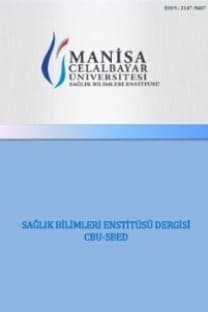Procalcitonin and C-reactive Protein Measurements in the Early Diagnosis of Surgical Site Infections After Cesarean Section
Sezaryen Sonrası Cerrahi Alan Enfeksiyonlarının Erken Dönem Tanısında Prokalsitonin ve C-reaktif protein Ölçümlerinin Yeri
___
1.Niino, Y, The increasing cesarean rate globally and what we can do about it, BioScience Trends,2011, 5(4), 139-150.2.Souza, J.P, Betran, A.P, Dumont, A, De Mucio, B, GibbsPickens, C.M, Deneux-tharaux, C, et al., A global reference for caesareansectionrates (C-Model): a multicountry cross-sectional study, BJOG:An International Journal of Obstetrics & Gynaecology,2016, 123(3), 427-36.
3.Zuarez-Easton, S, Zafran, N, Garmi, G, et al., Postcesarean wound infection: prevalence, impact, prevention, and management challenges, International Journal of Women's Health, 2017, 9, 81– 88.
4.Olsen, M.A, Butler, A.M, Willers, D.M, et al., Attributable costs of surgical site infection and endometritis after low transverse cesarean delivery, Infection Control & Hospital Epidemiology, 2010, 31(3), 276–282.
5.Salim, R, Braverman, M, Teitler, N, Berkovic, I, Suliman, A, Shalev, E, Risk factors for infection following cesarean delivery: an interventional study, The Journal of Maternal-Fetal & Neonatal Medicine, 2012, 25(12), 2708–2712.
6.Russwurm, S, Wiederhold, M, Oberhoffer, M, Stonans, I, Zipfel, PF, Reinhart, K, Molecular aspects and natural source of procalcitonin, Clinical Chemistry and Laboratory Medicine,1999, 37(8), 789-797.
7.Nijsten, M, Olinga, P, The, T.H, de Vries, E.G, Koops, H.S, Groothuis, G.M, et al., Procalcitonin behaves as a fast responding acute phase protein in vivo and in vitro, Critical Care Medicine, 2000, 28(2), 458-461.
8.Giovanella, L, Serum procalcitonin and calcitonin normal values before and after calcium gluconate infusion, Experimental and Clinical Endocrinology & Diabetes Reports, 2012, 120(3), 169-170.
9.Wacker C, Prkno A, Brunkhorst FM, et al. Procalcitoninas a diagnostic marker for sepsis: a systematic review and meta-analysis. The Lancet Infectious Diseases,2013, 13(5), 426–435.
10. Dandona, P, Nix, D, Wilson, M.F, Aljada, A, Love, J, Assicot, M, et al. Procalcitonin increase after endotoxin injection in normal subjects, The Journal of Clinical Endocrinology & Metabolism, 1994,79(6), 1605|-1608.
11. Recipon, G, Piver, E, Caille, A, et al., Is procalcitonin increased in cases of invasive amoebiasis? A retrospective, observational study, Diagnostic Microbiology and Infectious Disease, 2015, 83(4), 395– 399.
12. Chengfen, Y, Tong, L, Xinjing, G, Zhibo, L, Lei, X, Accuracy of procalcitonin for diagnosis of sepsis in adults: a Meta-analysis. Zhonghua Wei Zhong Bing Ji Jiu Yi Xue, 2015, 27(9), 743-749.
13. Linscheid, P, Seboek, D, Nylen, E.S, et al., In vitro and in vivo calcitonin I gene expression in parenchymal cells: a novel product of human adipose tissue, Endocrinology, 2003, 144(12), 5578–5584.
14. Potjo, M, Theron, A.J, Cockeran, R, Sipholi. N.N, Steel, H.C, Bale, T.V, Meyer, P.W.A, Anderson, R, Tintinger, G.R. Interleukin-10 and interleukin-1 receptor antagonist distinguish between patients with sepsis and the systemic inflammatory response syndrome (SIRS), Cytokine, 2019, 120, 227-233.
15. Caluianu EI et al., Utilizing Multiparameter Scores and Procalcitonin as Prognosis Markers for the Degree of Severity of Acute Pancreatitis, Current Health Sciences Journal, 2017, 43(4), 311-317.
16. Cossé, C, Sabbagh, C, Carroni, V, Galmiche, A, Rebibo, L, Regimbeau, J.M., Impact of a procalcitonin-based algorithm on the management of adhesion-related small bowel obstruction, Journal of Visceral Surgery, 2017, 154(4), 231-237.
17. Parli, S.E, Trivedi, G, Woodworth, A, Chang, P.K, Procalcitonin: Usefulness in Acute Care Surgery and Trauma, Surgical Infection (Larchmt),. 2018, 19(2), 131-136.
18. Whicher, J, Bienvenu, J, Monneret, G, Procalcitonin as an acute phase marker, Annals of Clinical Biochemistry, 2001, 38(5), 483-493.
19. Çetin, B.A, Mathyk, B.A, Koroglu, N, et al., Serum procalcitonin levels in incisional surgical site infections requiring a secondary suture after cesarean sections, The Journal of Maternal-Fetal & Neonatal Medicine, 2019, 32(24), 4108-4113.
20. Bond, M, Pilowsky, I. Subjective evaluation of its relationship with analgesic administration in pain and cancer patients. The Journal of Psychosomatic Research 1966, 10(2), 203-208.
21. Wang, T, Wang, H, Yang, D.L, Jiang, L.Q, Zhang, L.J, Ding, W.Y., Factors predicting surgical site infection after posterior lumbar surgery: A multicenter retrospective study, Medicine (Baltimore), 2017, 96(5), 6042.
22. Kara, S.S, Akbulut, A, Tartar, A.S, Akbulut, H.H, Demirdağ, K, Beştaş, A, Procalcitonin levels among patients with fever secondary to severe intracerebral infection, A cross-sectional study, Sao Paulo Medical Journal, 2019, 137(4), 349-355.
23. Oberhofer, D, Juras, J, Pavicic, A.M, et al., Comparison of Creactive protein and procalcitonin as predictors of postoperative infectious complications after elective colorectal surgery, Croatian Medical Journal, 2012, 53(6), 612–619.
24. Aljabi, Y, Manca, A, Ryan, J, Elshawarby, A, Value of procalcitonin as a marker of surgical site infection following spinal surgery, The Surgeon, 2019, 17(2), 97-101.
25. Takakura, Y, Hinoi, T, Egi, H, Shimomura, M, Adachi, T, et al., Procalcitonin as a predictive marker for surgical site infection in elective colorectal cancer surgery, Langenbecks Archives of Surgery, 2013, 398(6), 833–839.
- ISSN: 2147-9607
- Yayın Aralığı: 4
- Başlangıç: 2014
- Yayıncı: Manisa Celal Bayar Üniversitesi Sağlık Bilimleri Enstitüsü
Pektus Ekskavatum ve Pektus Karinatumlu Hastalarda Görülen Postür Bozuklukları
NURAY ALACA, İhsan ALACA, Atılay MORGÜL
Tolga Onur BADAK, Ahmet İhsan İŞKESEN
Akut ST Yükselmeli Miyokard Enfarktüsünde Sol Ana Koroner Stentleme Olgusu
Hakan GÖÇER, Ahmet Barış DURUKAN
COVID-19 Hastalığı Tanı ve Tedavisinde Kullanılan Laboratuvar Testleri
İsmail BOZKURT, Gönül TEZCAN KELEŞ
Kanserin Önlenmesi ve Tedavisinde Polifenollerin Rolü
